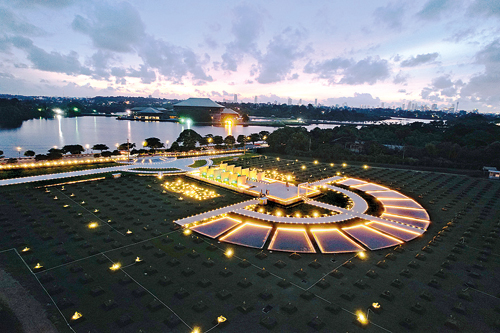Newest green oasis where sandalwood trees take root
View(s):
Still young: Sandalwood trees planted on raised plots
The National Sandalwood Park, nestled adjacent to the House of Parliament and the Diyawanna Oya is a welcome addition to the city’s green spaces. Designed by the Environment & Landscape Division of the Urban Development Authority (UDA) and constructed by the Sri Lanka Land Development Corporation (SLLDC), at a cost of around Rs 300 million, it was opened by Minister Namal Rajapaksa on July 20.
The nine-acre site is divided into different zones for easy maintenance and 900 White sandalwood trees (Santalum album) and 300 Red sandalwood trees (Pterocarpus santalinus) have been planted 15 by 15 feet apart on two and half foot high platforms to mitigate the existing high-water table. Water and fertilizer are drip irrigated to the plants.
Landscape architect Kosala Tennekoon who planned the site explains that the two types of sandalwood trees are totally different, although sharing the common name of ‘sandalwood’ and bearing a similar strong lasting fragrance.

Kosala Tennekoon
The concrete structure which greets a visitor, is an outdoor theatre with symmetrically placed water cascading walls and matching low-level ponds. The music and colours of the lights can be changed to suit the mood of any outdoor event to be staged at the theatre, Kosala adds. A perimeter walking path is being constructed with solar powered lighting.
As dusk approaches, the landscape of the park changes dramatically. The shadows lengthen over the sandalwood plants, and as twilight gives way to the last light of day, artificial lights of red, yellow, blue and green turn on to the water cascading walls, transforming the park to a fairyland of soft lighting. The pathways and the trees are lit with spotlights and up lights to give a magical ambiance with background music of chirping birds and flowing water wafting through the air.
Kosala, a Chartered Architect, the landscape designer of the Sandalwood Garden is a proud product of Mahamaya College Kandy, having graduated from the University of Moratuwa and obtained a MSc from the University of Peradeniya in Floriculture and Landscape Architecture. Kosala received a Sri Lanka Institute of Architects Award for Landscape Architecture for her work on the Arcade Independence Square landscape environment.
Kosala explains that White and Red Sandalwood are of the oxygenous plant species and are native to Southern India and Southeast Asia. They are slow growing perennial trees which live up to a hundred years. It takes 10 to 15 years for the heartwood of Sandalwood trees to form and it is considered one of the most expensive woods in the world, due to its cosmetic and therapeutic values.
White sandalwood is not recommended to be planted as a monoculture due to the parasitic nature of its roots, so the common Mukunuwanna (Altenantera sessitis) is grown at the base of each plant to feed on and provide nutrients to the mother plant. Kosala envisages planting Kathurumurunga (Sesbania grandiflora), also known as the Humming Bird Tree in the event that Mukunuwanna is inadequate to provide the nutrients required for the white sandalwood trees.
Parks and open spaces are an integral part of a city and play a key role in the health and well-being of its citizens. At the end of the war, Colombo saw the addition of numerous large parks, for recreation and contemplation for the urban population. The Arcade and Independence Square surrounds, Nugegoda Wetland Park and Baddegana Wetland Park with its unique biodiversity to name a few, are dynamic people-centric open spaces, thanks to the initiative of the Urban Development Authority (UDA) who are the key implementers of these landmark projects.

Magical sight: An aerial view of the illuminated park at twilight
This Sandalwood Garden with its aesthetic appeal, is one of the destinations in the Green Garden Network that is being developed by the UDA.
Parks and gardens integrated into the life of the city have been an ancient tradition of our country. The first recorded gardens, Nandana and Mahameghavana Uyana in Anuradhapura, a world heritage site were designed by King Matasiva in 367 BC as stated in the Mahavansa.
The Chulavansa records the world renowned Sigiriya Gardens, yet another world heritage site (477 – 495 AD) designed by King Kashyapa. With its water gardens, boulders and terraces, amidst pathways of trees, it is a fusion of symmetrical and asymmetrical planning. In 1807 King Sri Wickrema Rajasinghe showcased the Kandy Lake adjacent to the Temple of the Tooth, with a backdrop of forest trees giving the city its unique identity and landscape.
The park which is open to all will provide an array of health benefits for urban dwellers, by improving physical and psychological health, providing space to socialize and enjoy musical events and recreation. Sandalwood trees when fully grown will reduce atmospheric temperature, absorb carbon dioxide and air pollutants, and provide the life-giving oxygen which these trees are known for.
“He who plants a tree, plants Hope!” – Lucy Laycom.
This article was contributed by Ruk Rakaganno- The Tree Society of Sri Lanka.
They can be contacted at rukrakaganno09@gmail.com


